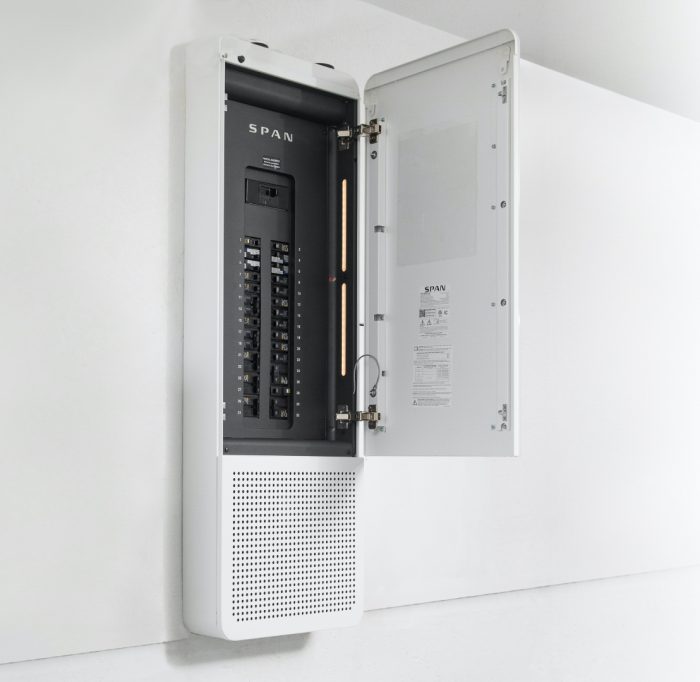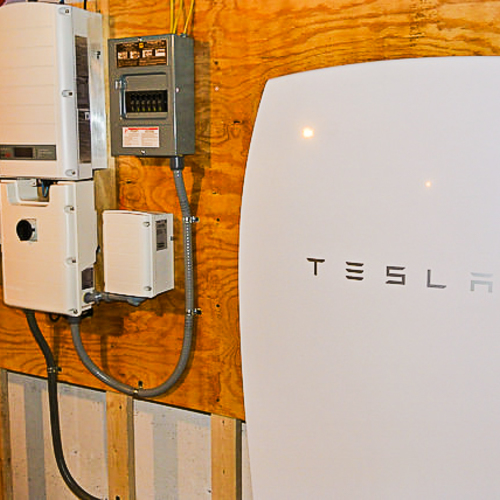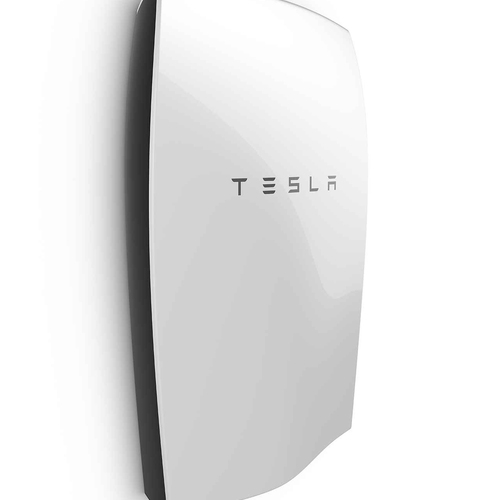
Within the next few months, Vermont’s largest electric utility will begin replacing conventional electric service panels in 100 carefully selected homes with a reinvented version that gives customers unprecedented control over their use of electricity.
Green Mountain Power thinks the recently announced pilot program—one of the first of its kind in the U.S.—holds promise not only for the customers who get the devices but also for the utility as it steers itself toward a fully clean-power future and a modernized grid.
A standard service panel controls the flow of electricity with a number of individual breakers that are either on or off. The Span Smart Panel is an interactive device that lets customers control power to individual circuits via a smart phone app, as well as manage the distribution of power to other devices, such as electric vehicle chargers and solar battery storage. The smart panel also can meter the use of electricity, replacing conventional meters now in use.
Customers chosen to be part of the rollout will get the smart panels installed for free. It’s a $500,000 bet that Green Mountain Power (GMP) is placing on a new technology that will help it remake the grid. The company, a privately held utility serving some 266,000 residential and business customers in Vermont, has already launched programs to promote the installation of Tesla Powerwall batteries and electric vehicle chargers as it pushes for a carbon-free grid by 2025.
The utility says those programs already are paying off. The thousands of Tesla Powerwall batteries it has installed in the homes of customers gives it a source of stored energy during times of peak demand, and helped save Green Mountain $3 million in 2020.
As more homeowners turn to solar panels, electric vehicles, heat pumps, and battery storage, managing the distribution of electricity becomes more important.

In a press release describing the pilot program, GMP President and CEO Mari McClure said a smart panel would alert customers when the power goes out and allow them to manage backup electricity from a battery remotely via a smart phone.
The potential flexibility of the system should be a big draw for customers even as it helps the utility, GMP communications director Kristin Kelly said in a telephone call:
“If you’re looking at a future where customers have an electric vehicle, heat pumps, solar, battery,” she said, “all this stuff happening in the home on the electrical system, wouldn’t it be awesome if there were once device that could help manage all of that for the customer and the utility without a lot of upgrades and changes.”
Kelly said GMP would be looking for several types of customers: some who already have installed solar panels, some with electric vehicle chargers, some with battery storage, and even those with just an electric water heater. The intent is to see how the panel works in different scenarios. Installation crews already have been trained, Kelly said, and the first of the panels could be going in by June.
In its filing with the Vermont Public Utilities Commission, the utility said the pilot program was part of an ongoing effort to introduce new technologies and lower costs for consumers. “As we continue to innovate on behalf of our customers, GMP is always looking for hardware, software and services that can deliver solutions to improve reliability, reduce carbon and reduce cost for all,” Craig Ferreira of the utility’s innovation development arm wrote. “As more devices in the home gain the ability to help with load management, creating a central gateway, or access point, will help to reduce the number of one-by-one integrations needed, providing greater ease and flexibility for both our customers and GMP.”
Ferreira said the utility has been watching the development of smart panels for several years. Span, he said, is the first company to develop a UL-certified panel with all of the monitoring and control features it wanted as a full replacement for traditional panels. (For a look at the utility’s full PUC filing, read Span filing).
“As people switch to solar and install more and more solar and more and more batteries and switch to EVs, they are going to need to do electric upgrades,” Kelly said. “They’re going to want more control over these systems and the current electric panel doesn’t always accommodate all of that. As a utility that’s already in the space of storage and electric vehicles and all of that, it’s a natural fit. It’s a different way of looking at things. So we’re trying it. We’re already on that transition path anyway.”
Living with a Span panel
Adding a battery to a PV system keeps the power going for key appliances or circuits when the grid goes down. In an article posted at Wired, however, Christopher Null listed the shortcomings of these systems, including an inability to change loads when circuits are hard-wired, and what he called the “poor visibility” that the inverter’s app provides into total power consumption in the home.
After posting his complaints in an earlier article, Null was approached by Arch Rao, CEO at Span and former head of product at Tesla. Rao offered to replace Null’s conventional service panel with a Span panel.
Sure, Null said. Installation took about nine hours, after which Null could settle in with the Span app and begin learning how to use its new capabilities.
“It didn’t take long to see exactly how much I had been missing” Null writes. “The primary screen within the app shows where power is coming from (solar, battery, or grid), and where it’s going (to the home, back to the battery, or back to the grid), all in real time. From there, it’s easy to drill down and get insights into (almost) every circuit in my home, detailing each circuit’s current power draw and, as time went on, how much power each circuit is eating up.”
More important, the panel allowed Null to control how power from the battery is being used. Circuits are divided into categories—must have, nice to have, and not essential—and swapping circuits into another category is simply a drag-and-drop operation in the app, he said.
Although he had some quibbles with the system, including a retail price tag that can range from $6,000 to $7,500, Null called the system a “long-overdue” product that could shake up a stodgy industry that hasn’t seem much progress since the 1960s.
The three-year-old, privately held company would not discuss sales figures, but through a spokeswoman said that it has been installing panels in homes around the country since the summer of 2020. It closed on a $20 million round of funding in January. In addition to the Green Mountain Power project, Span also is partnering with Silicon Valley Clean Energy to install panels in the SVCE service area as part of an effort to reduce natural gas emissions.
For the record, there’s a note at the bottom of Null’s article disclosing that the panel was installed for a “nominal fee” and that it would not be returned after the review was published. Further, Wired says it may earn a commission when readers buy products using links in published articles.
Scott Gibson is a contributing writer at Green Building Advisor and Fine Homebuilding magazine.
Weekly Newsletter
Get building science and energy efficiency advice, plus special offers, in your inbox.















6 Comments
I'm very glad to see that products like this are starting to hit the market. I'm planning on installing solar + battery in a couple years and was hoping that there would be a corresponding smart management solution available when that happened.
Two things jump out at me, though.
First, that price of $6k-$7.5k seemed incredibly low.. but then, the only quote I've ever received for upgrading my electrical panel was $10k and yes, that did included a lot more than just upgrading the box. Still, the "new electrical panel" anchor price was $10k in my mind, so less than that is a bonus!
Second, I cannot find any info either on their site or in articles written about them on just how "cloud-centric" this all is. Management is done via an app, which strongly suggests that the panel reaches out to the cloud. Apps absolutely can work entirely locally, but that's far more rare than I'd like it to be. If it's all routed through the Span cloud, then what kind of control do they have over the data? Over the functionality? Are subscriptions going to be necessary in the future to manage your own panel? If Span goes out of business, will the panel stop working?
To re-set your anchor point a bit, I read the article as the panel itself being $6-7k, which is incredibly high in the world of "dumb" residential panels, though it's a unique product that can't really be compared apples to apples. Nonetheless, compare I will -- retail price for a standard 200A main breaker panel could be sub-$200, though depending on how many circuits and what mix of AFCI, GFCI, and standard breakers you needed, it wouldn't be crazy to spend another $1000 on breakers (again, retail pricing, I'm sure pros can get better volume pricing from distributors -- or at least could prior to this year's supply chain situation.)
Doing a full panel replacement is a lot of work, though -- like, several hours at least -- and depending on the age and condition of your electrical system, there could be a lot of extra or unforseen problems that crop up, or other materials required. Also, as you said your quote included more than just upgrading the box -- if you were looking at upgrading the size of the service, there's also some (thick, expensive) wire, a new meter enclosure, coordination with the utility, etc. to include.
Point being, a normal / dumb residential breaker panel full of breakers is going to cost maybe $1-1.5k, versus this at $6-7.5k -- so $5-6k for the smarts. That's not to say it's unreasonable -- it's a specialized, low volume product hardware that would have had to undergo some substantial certification testing (UL / FCC / etc.) -- but if you're looking to have one professionally installed, I'd imagine it's going to be substantially more than the retail price quoted here.
Your second point is very valid, and something I'd be quite concerned about as well. So far I've made sure all the "cloud enabled" stuff in my house isn't "cloud dependent" -- it does everything I need it to without an internet connection, and I can choose to give it an internet connection or not depending on whether I want the added convenience features or not.
I just went to their website. It says: "Span costs $3,500 plus installation". That's for a 200 Amp panel without breakers. It appears to take care of the grid disconnect and transfer switch, and provides dynamically customizable critical loads functionality instead of a hardwired panel.
I had been interested in Leviton's smart panel before, but this provides flexibility way above and beyond that. I imagine the only advantage smart breakers, like Leviton's, would have would the ability to tweak the parameters for tripping their AFCI's. I've heard those can be finicky at times. I've heard of at least one case where someone was having problems, and Leviton was able to adjust them. I'm not sure how real-world that actually is. I have power outages once or twice a year, and the Span functionality looks awesome.
Thanks Scott. This is an intriguing product. Do you have any sense on whether it could be configured to manage loads to enable homes with smaller service panels to go all-electric without having to upgrade their service? Where I live a neighbor is considering going all electric but he got a $40,000+ quote from the utility to upgrade his service from 100 to 200A, since the lines are underground. It's a huge barrier. But if using Span you could set a not-to-exceed overall amperage and then prioritize which circuits to disconnect if you start to get close to that limit, then it would enable many more households to go all electric. This seems like a great application for this product, but I don't see it mentioned anywhere on their site. Am I misinterpreting its capabilities? Thanks for any insight you can offer.
Hi Chris, I am in the position you speak of. My quote for increasing amps from 100 to 200 is 15 - 20 K, for the same reasons. My contractor has offered a smart solution add on to a new pane (which is required) due to the extra load. I'd love to know of someone else who has done this. I might be the first one here.
I agree. While the smart solution is new, it's price seems high to me, as my lap top can do more, and it costs 1/3 of the price.
So far I've cut the gas to my home, not used any since Nov, but want to get the central heat going soon. I live in Calgary, Ab! My excel. building envelope retrofit allowed me to go the winter using space heaters. I've been waiting to sort out the electric solutions, with no help from our city-owned utility (cost sharing of the inevitable upgrade would be nice!)
I'm kind of on my own here, following Greta's advice to pass every decision through a climate crisis lens. I'm definitely not in favour of spending thousands on a new gas furnace when we need to stop GHGs.
Compared to the utility's cost to increase the amps that would permit me to meet code on the electrical systems (heating space and water), the smart panel is much less. But compared to my laptop, it's a lot! And I don't want it to have the problems of my lap top, which include planned obsolescence and cloud impositions/interruptions/messaging...
So I very much appreciate hearing anyone else's experience! Thank you!
Chris, has your neighbor installed monitoring to see what their actual usage is and tried doing the serviced capacity calculation on that basis? It can result in a much lower number than the standard approach. See https://www.greenbuildingadvisor.com/article/does-your-electrification-project-require-a-service-upgrade for the standard approach and the comments for the monitoring approach.
Log in or create an account to post a comment.
Sign up Log in